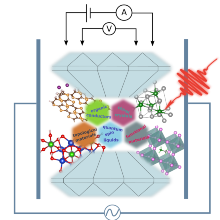General Description
In 1. Physics Institute, we employ several experimental methods to explore the high-pressure effects on various compounds. Since the external pressure is a clean tuning parameter of material properties as opposed to the chemical tuning, it can be utilized to investigate a multitude of phenomena: Here in PI1, we are specifically interested in insulator-metal transitions, structural and vibrational properties, quantum phase transitions, memory effects, and topological properties under pressure. The materials of interest covers the organic conductors, quantum spin liquids, organic-inorganic functional materials, and topological systems.
EQUIPMENT
Tools for sample preparation:
- Sample holder: CuBe gaskets for diamond anvil cells (DACs)
- Drilling the sample space: We use an electric discharge machine to prepare the sample space for the measurements
- Pressure manometers: Manganin coils and InSb bars are utilized for the piston-type cells, while ruby spheres are in use for DACs
- The pressure transmitting medium: Daphne oil is used in our piston-type pressure cells and our DAC for dielectric spectroscopy. In our IR-DAC assembly, CsI is chosen as a pressure medium. A Nitrogen-filling option is also available for the IR-DAC
- Ruby luminescence: OceanOptics HR2000+ CCD spectrometer is coupled with our experimental setups for pressure calibration
Experimental setups
High-pressure dielectric spectroscopy
The dielectric spectroscopy technique usually employs a parallel capacitor configuration and the frequency-dependent measurements with a reliable signal-to-noise ratio are established as a standard spectroscopic tool. On the other hand, the inclusion of the external pressure to this technique is not straight forward: The electrodes in the capacitor configuration should be introduced to the sample space while maintaining the pressure environment is challenging. In PI1, we overcome these difficulties with customized electrical feedthroughs that enable us to perform frequency-dependent measurements up to 5 MHz with around 40 fF stray capacitance. Measurements can be performed down to 4 K and under the magnetic field, as well.
Technique overview: R. Rösslhuber, E. Uykur, and M. Dressel, Rev. Sci. Instrum. 89, 054708 (2018)
High-pressure infrared spectroscopy
Infrared spectroscopy is a powerful tool to investigate the vibrational dynamics, phase transitions, and topological properties of materials. High-pressure emerged as a promising tuning parameter that allows one to observe distinctive properties on the proposed materials.
In PI1, we tackle the problems with two different setups: The low-temperature low-pressure set up allows us to investigate the materials up to 17 kbar down to 6 K in a broad frequency range (10 meV – 2 eV). This setup is especially suitable for materials where the electronic structure can be tuned in a small pressure regime, such as organic conductors.
The high-pressure IR spectroscopy setup allows for measurements up to 12 GPa, which is especially useful for inorganic materials where one principally needs a higher pressure range to tune the electronic structure. The broadband measurements, as in the low-pressure counterpart, are also possible along with the lowest temperatures.
Technique overview: R. Beyer and M. Dressel, Rev. Sci. Instrum. 86, 053904 (2015)
High-pressure dc resistivity measurements
DC transport is a versatile tool for the investigation of the materials’ properties. Insulating as well as the metallic samples can be investigated with a well established measurement methods. It is also one of the commonly employed techniques in the high pressure investigations. Here in PI1, we use a piston type pressure cell for the dc resistivity and magneto-resistance measurements up to 30 kbar external pressure and 6 Tesla magnetic field.
High-pressure studies in PI1
1. Rodriguez et al., Phys. Rev. B 101, 174104 (2020)
2. Rodriguez et al., Phys. Rev. Lett. 124, 136402 (2020)
3. Li et al., Phys. Rev. B 99, 115137 (2019)
4. Biesner et al., Phys. Rev. B 97, 220401(R) (2018)
5. Pustogow et al., Nature Materials 17, 773 (2018)
6. Löhle et al., Phys. Rev. B 95, 195146 (2017)
7. Löhle et al., J. Phys.: Condens. Matter 29, 055601 (2017)
8. Voloshenko et al., J. Phys.: Condens. Matter 29, 115601 (2017)
9. Beyer et al., Phys. Rev. B 93, 195116 (2016)








